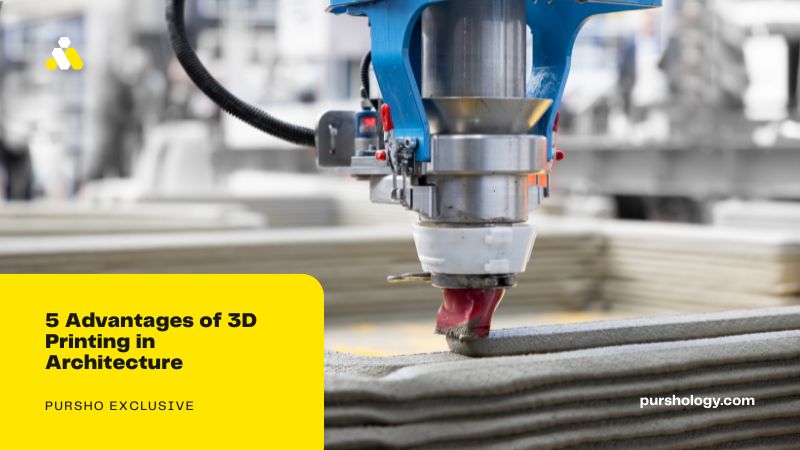The dynamic intersection of technology and architecture has brought about groundbreaking advancements, propelling the field into new realms of design excellence and construction efficiency. One such groundbreaking innovation that has garnered significant attention and transformed the industry is 3D printing. With 3D printing, architects can create intricate and detailed architectural elements with ease, enabling the realization of complex geometries and organic shapes that were previously challenging to construct.
For many years, architects and builders have faced limitations imposed by traditional construction methods. However, 3D printing in architecture presents a paradigm shift. Through this technology, complex geometries and intricate details that were once challenging to achieve can now be effortlessly realized. Architects can unleash their creativity and explore unconventional forms, resulting in visually striking and aesthetically pleasing designs that were previously inconceivable.
Increased Design Freedom
3D printing technology provides architects with unparalleled design freedom, enabling the realization of complex and intricate forms that were once difficult to achieve using traditional construction methods. The revolutionary impact of 3D printing in architecture has shattered the limitations imposed by conventional construction, empowering architects to bring intricate details and custom geometries to life. This newfound freedom allows for innovative and unconventional designs that push the boundaries of architectural aesthetics. By leveraging 3D printing, architects can transform their conceptual ideas into tangible structures that embody their creative vision.
Cost-Effectiveness
Unlike traditional construction methods that often generate substantial material waste, 3D printing utilizes additive manufacturing techniques that deposit materials in precise quantities, minimizing waste. By reducing material costs, it promotes a more sustainable construction process. Additionally, 3D printing can streamline the construction timeline, reducing labor costs associated with traditional construction methods. The ability to rapidly fabricate components and assemblies using 3D printing technology can result in significant time and cost savings for architectural projects.
Sustainability
Sustainability is a critical concern in architecture, and 3D printing offers a range of benefits in this regard. To begin with, 3D printing empowers architects to employ environmentally friendly materials that have a reduced ecological footprint in comparison to conventional construction materials. For example, the use of bio-based and recycled materials in 3D printing contributes to a more sustainable and circular approach to building. Secondly, 3D printing minimizes waste by only using the necessary amount of material, reducing construction waste and its associated environmental footprint. Additionally, 3D printing can optimize resource utilization, as intricate designs can be achieved with minimal material usage. By embracing 3D printing technology, architects can contribute to the development of environmentally conscious and sustainable architectural practices.
Innovative Construction Techniques
3D printing introduces innovative construction techniques that can revolutionize the way buildings are constructed. By utilizing large-scale 3D printers, architects can fabricate complete building components, including walls and facades, as a single unit, eliminating the requirement for assembly and significantly reducing construction time. This approach, known as contour crafting, allows for the rapid construction of buildings with increased precision and efficiency. Moreover, 3D printing enables the integration of functional features directly into the printed elements, such as embedded channels for utilities or intricate structural patterns. These innovative construction techniques not only enhance efficiency but also open up new possibilities for architectural expression.
Customization and Adaptability
3D printing technology empowers architects to create highly customized designs that cater to specific project requirements. From parametric design approaches to tailored structural elements, 3D printing allows architects to create bespoke solutions that meet unique design challenges. Additionally, 3D printing enables easy modification and adaptation of designs. With the ability to quickly iterate and adjust digital models, architects can respond to changes and optimize designs throughout the construction process. This adaptability and customization offered by 3D printing enhance the overall efficiency and effectiveness of architectural projects.
Case Studies and Real-world Examples
To showcase the advantages of 3D printing, numerous case studies and real-world examples exist. From intricate facades and complex structural components to sustainable and cost-effective housing solutions, these examples demonstrate the transformative impact of 3D printing in the architectural realm. By studying accomplished ventures, including the construction of buildings using 3D printing or the development of personalized architectural elements, we can directly witness the groundbreaking influence of 3D printing on architectural design and construction methodologies.
One notable real-life example that demonstrates the customization and adaptability of 3D printing in architecture is the “Vulcan Pavilion” designed by the Beijing-based Laboratory for Creative Design (LCD). It has been awarded the title of “largest 3D printed structure” by the Guinness World Records. The tripodal pavilion is composed of three arched tunnels that converge towards the central polyhedron core. Drawing inspiration from the silkworm, the pavilion showcases a sinuous membrane that envelops its structure. The design incorporates polygonal facets, mimicking the intricate patterns found in silk and cocoon production. To bring this vision to life, a team of 15 individuals utilized 20 large-scale 3D printers to fabricate the polygonal facets with precision and detail.
LCD Architect Yu Lei expressed that VULCAN signifies a paradigm shift where contemporary architects can now attain their envisioned design excellence throughout the entire process, encompassing conception, construction, and implementation, through the utilization of digital design and fabrication methodologies. Lei further added that this advancement will progressively blur the demarcations between technology and art.
In conclusion, the advantages of 3D printing in architecture are truly remarkable. From increased design freedom and cost-effectiveness to sustainability, innovative construction techniques, and customization, this technology has revolutionized the way architects approach their projects. With the utilization of 3D printing, architects can explore new frontiers of creativity, conceive structurally intricate designs, minimize material wastage, and actively contribute to a sustainable future. As we bear witness to pioneering projects and constant advancements in the field, it becomes evident that 3D printing will exert a growing and influential impact on shaping the future of architecture.







